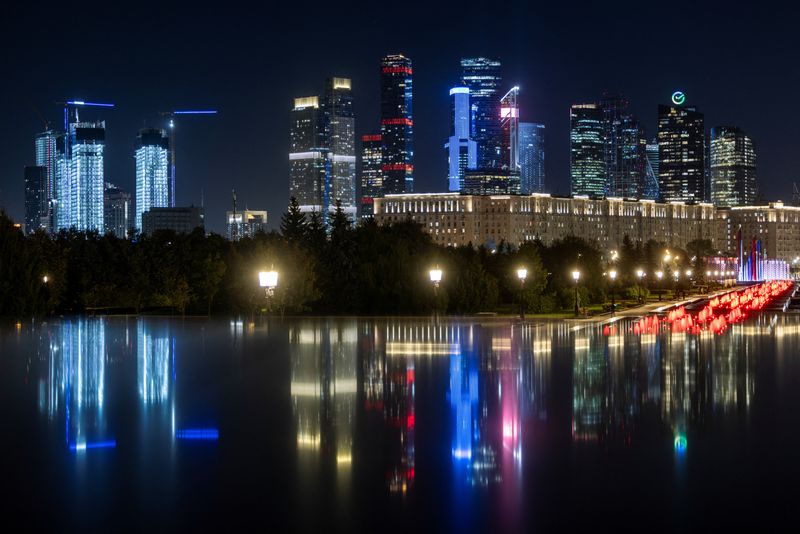By Darya Korsunskaya
(Reuters) - A sharper rise in capital investment is one of many improvements to Russia's 2024 economic outlook, new economy ministry forecasts showed, though stubbornly accelerating inflation may blunt the impact of faster rises in household incomes.
Russia's economic growth relies heavily on large-scale government spending on arms production as Moscow funds its war in Ukraine, which has led to soaring wages in a tight labour market and strong consumer demand even with interest rates at 18%.
Moscow now expects gross domestic product (GDP) to climb 3.9% in 2024, up from 2.8% in the forecast it issued in April, Finance Minister Anton Siluanov said last week.
The baseline forecasts from the economy ministry are used by the finance ministry for its budget calculations.
The government's expectations now exceed those of analysts polled by Reuters, who see GDP growth of 3.6% in 2024.
Russia now expects to record two years of strong economic growth, improving on a 3.6% expansion in 2023 and following a 1.2% contraction in 2022 as Moscow grappled with a barrage of Western sanctions over the invasion of Ukraine.
But inflation is also seen climbing. The economy ministry expects annual inflation to end the year at 7.3%, up from 5.1% envisaged in April, and just shy of a 7.4% reading in 2023. Those sharp rises follow an 11.9% jump in prices in 2022.
It raised its expectations for real wage and disposable income growth significantly, both of which are seen expanding faster than the economy and labour productivity, continuing to push up consumer demand, which combined with record government spending and the rouble's 2023 slide have fanned inflation.
Several interest rate hikes by the central bank to a more than two-year high of 18% have failed to curb price rises, and inflation will not return to the bank's 4% target until at least 2026.
The ministry's growth forecasts for retail trade turnover, capital investment and industrial output in 2024 were also raised.
The improvements it sees in most forecasts are predicated on raised expectations for Russia's energy exports, with prices for oil and gas both seen higher than in the April forecasts.
The rouble is expected to trade a little stronger than previously forecast, averaging 91.2 per dollar this year and 96.5 next. The Russian currency is seen ending 2026 at 100/dollar and gradually weakening deeper into triple figures every year going forward.
The economy ministry forecast suggests Russia's tight labour market is here to stay, with unemployment seen remaining at what would be a record annual low of 2.6% until at least 2030.
Hundreds of thousands of people have fled Russia or joined the military since Russia launched its invasion of Ukraine.
Below is a table with the economy ministry's forecasts for 2024-27. The previous forecasts, from April 2024, are in brackets:
INDICATOR 2023, 2024 2025 2026 2027
fact
Oil price, 82.6 83.5 81.7 77.0 74.5
Brent, $/bbl (79.5) (75.1) (72.0) (71.2)
Export price 64.5 70.0 69.7 66.0 65.5
for Russian (65.0) (65.0) (65.0) (65.0)
oil, $/bbl
Dollar/rouble 84.7 91.2 96.5 100.0 103.2
rate (94.7) (98.6) (101.2) (103.8)
Exports, 424.5 427.6 445.0 455.2 476.2
billion $ (428.7) (455.7) (473.8) (496.0)
Imports, 302.9 294.9 321.9 342.6 357.4
billion $ (324.1) (349.4) (365.1) (373.7)
Trade balance, 121.6 132.8 123.0 112.7 118.9
billion $ (104.5) (106.4) (108.7) (122.3)
Current account 50.1 51.2 36.4 23.2 25.1
balance, (27.9) (26.6) (25.3) (34.0)
billion $
GDP growth, % 3.6 3.9 2.5 2.6 2.8
(2.8) (2.3) (2.3) (2.4)
Industrial 3.5 4.0 2.0 2.4 2.6
output growth, (2.5) (2.3) (2.3) (2.5)
%
Year-end 7.4 7.3 4.5 4.0 4.0
inflation rate, (5.1) (4.0) (4.0) (4.0)
%
Capital 9.8 7.8 2.1 3.0 3.3
investment (2.3) (2.7) (3.0) (3.2)
growth, %
Retail trade 8.0 8.6 7.6 6.1 4.1
turnover, % (7.7) (4.8) (3.9) (3.1)
Real wages, % 8.2 9.2 7.0 5.7 4.1
(6.5) (3.6) (2.8) (2.5)
Real disposable 5.8 7.1 6.1 4.6 3.4
incomes, % (5.2) (3.5) (3.0) (2.6)

Unemployment, % 3.2 2.6 2.6 2.6 2.6
(3.0) (3.0) (3.0) (3.0)